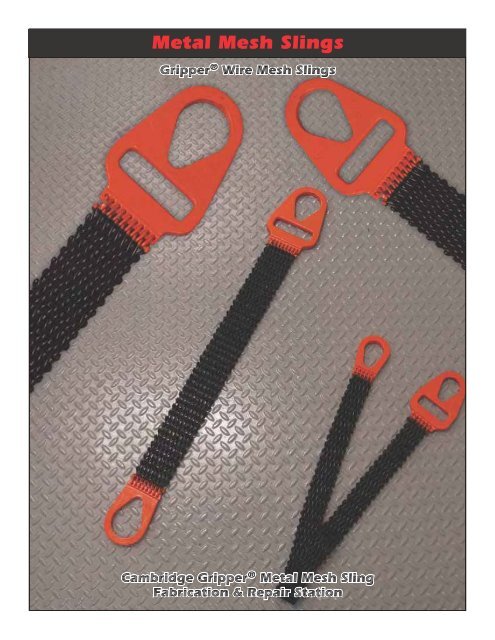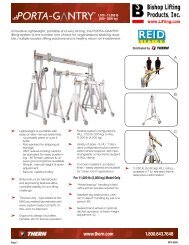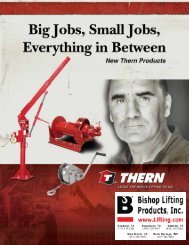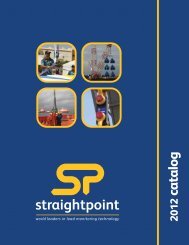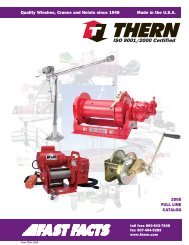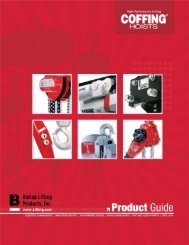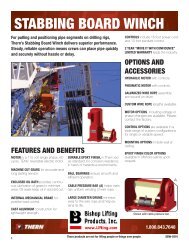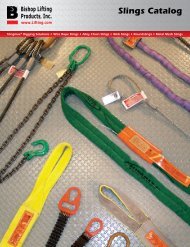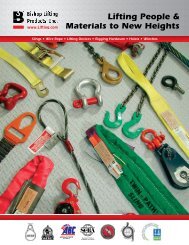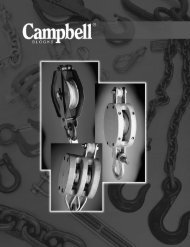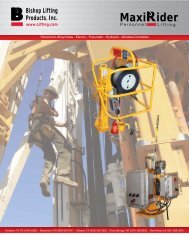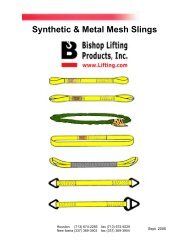Metal Mesh Slings
Metal Mesh Slings
Metal Mesh Slings
You also want an ePaper? Increase the reach of your titles
YUMPU automatically turns print PDFs into web optimized ePapers that Google loves.
<strong>Metal</strong> <strong>Mesh</strong> <strong>Slings</strong><br />
Gripper ® Wire <strong>Mesh</strong> <strong>Slings</strong><br />
Cambridge Gripper ® <strong>Metal</strong> <strong>Mesh</strong> Sling<br />
Fabrication & Repair Station
Length<br />
(Feet - In)<br />
<strong>Metal</strong> mesh sling with choker and basket fi tting<br />
Features:<br />
G-35 heavy duty metal mesh, carbon steel, 10 gauge<br />
Tolerates temperatures up to 550° F, or even higher, when made of special alloy<br />
<br />
Proof tested to 2X rated capacity<br />
Design factor of 5 to 1<br />
How to order:<br />
Combine model and length in feet<br />
Model<br />
Type 1<br />
Part Number<br />
Length Feet<br />
Width<br />
Inches<br />
Choker<br />
Vertical<br />
Basket<br />
Rated Capacities in Lbs.<br />
Basket<br />
60° from<br />
Horizontal<br />
Basket<br />
45° from<br />
Horizontal<br />
WARNING<br />
See metal mesh slings warnings page<br />
for warnings and inspection criteria<br />
Basket<br />
30° from<br />
Horizontal<br />
1MM02X * 2 1,600 3,200 2,700 2,000 1,600<br />
1MM03X * 3 3,000 6,000 5,100 3,800 2,800<br />
1MM04X * 4 4,400 8,800 7,480 5,600 4,400<br />
1MM06X * 6 6,600 13,200 11,225 8,400 6,600<br />
1MM08X * 8 8,800 17,600 15,000 11,250 8,800<br />
1MM10X * 10 11,000 22,000 18,700 14,000 11,000<br />
1MM12X * 12 13,200 26,400 22,440 16,800 13,200<br />
1MM14X * 14 15,400 30,800 26,180 19,600 15,400<br />
1MM16X * 16 17,600 35,200 29,920 22,400 17,600<br />
1MM18X * 18 19,800 39,600 33,660 25,200 19,800<br />
1MM20X * 20 22,000 44,000 37,400 28,000 22,000<br />
Note:<br />
<br />
See dimensional data page for weights<br />
METAL MESH<br />
SLINGS<br />
<strong>Metal</strong> <strong>Mesh</strong> <strong>Slings</strong> 134<br />
(800) 972-1041
Length<br />
(Feet - In)<br />
2MM -Type 2<br />
<strong>Metal</strong> mesh sling with basket fi tting each end<br />
Features:<br />
G-35 heavy duty metal mesh, carbon steel, 10 gauge<br />
Tolerates temperatures up to 550° F, or even higher, when made of special alloy<br />
<br />
Proof tested to 2X rated capacity<br />
Design factor of 5 to 1<br />
How to order:<br />
Combine model and length in feet<br />
Model<br />
Type 2<br />
Part Number<br />
Length Feet<br />
Width Inches<br />
Vertical Basket<br />
Basket<br />
60° from<br />
Horizontal<br />
Rated Capacities in Lbs.<br />
Basket<br />
45° from<br />
Horizontal<br />
WARNING<br />
See metal mesh slings warnings page<br />
for warnings and inspection criteria<br />
Basket<br />
30° from<br />
Horizontal<br />
2MM02X * 2 3,200 2,700 2,000 1,600<br />
2MM03X * 3 6,000 5,100 3,800 2,800<br />
2MM04X * 4 8,800 7,480 5,600 4,400<br />
2MM06X * 6 13,200 11,225 8,400 6,600<br />
2MM08X * 8 17,600 15,000 11,250 8,800<br />
2MM10X * 10 22,000 18,700 14,000 11,000<br />
2MM12X * 12 26,400 22,440 16,800 13,200<br />
2MM14X * 14 30,800 26,180 19,600 15,400<br />
2MM16X * 16 35,200 29,920 22,400 17,600<br />
2MM18X * 18 39,600 33,660 25,200 19,800<br />
2MM20X * 20 44,000 37,400 28,000 22,000<br />
Note:<br />
<br />
See dimensional data page for weights<br />
METAL MESH<br />
SLINGS<br />
(800) 972-1041 <strong>Metal</strong> <strong>Mesh</strong> <strong>Slings</strong> 135
METAL MESH SLING WARNINGS<br />
When inspecting a metal mesh sling, it shall be taken out of service immediately and returned for repair or replacement when any<br />
of the below defects are present.<br />
Missing or illegible sling<br />
identification<br />
Distortion of either<br />
fitting so that the width<br />
of the eye opening is<br />
decreased more than<br />
10%<br />
Broken weld or a broken<br />
brazed joint along the<br />
sling edge<br />
Broken wire in any part<br />
of the mesh<br />
A 15% reduction of the<br />
original cross-sectional<br />
area of any point around<br />
the hook opening of the<br />
end fitting<br />
Visible distortion of<br />
either end fitting out of<br />
its plane<br />
Reduction in wire<br />
diameter of 25% due to<br />
abrasion, or 15% due to<br />
corrosion<br />
Cracked end fitting<br />
Lack of flexibility in the<br />
mesh due to distortion<br />
of the mesh<br />
<strong>Slings</strong> in which the<br />
spirals are locked or<br />
without free articulation<br />
shall not be used<br />
Distortion of the choker<br />
fitting so the depth of<br />
the slot is increased by<br />
more than 10%<br />
Fittings that are pitted,<br />
corroded, cracked, bent,<br />
or twisted, gouged, or<br />
broken<br />
METAL MESH<br />
SLINGS<br />
and… Any condition that causes doubt about the<br />
continued use of the sling<br />
<strong>Metal</strong> <strong>Mesh</strong> <strong>Slings</strong> 136<br />
(800) 972-1041
Overall Sling Length<br />
C<br />
DD<br />
Fabric Length<br />
B<br />
H<br />
G<br />
A<br />
Sling Width<br />
G<br />
E<br />
F<br />
Usable Length for<br />
Choke Hitch<br />
F<br />
E<br />
Usable Length for<br />
Basket Hitch<br />
Dimensional Data<br />
Sling Width<br />
See drawing above<br />
A" B" C" D" E" F" G" H" DD"<br />
Hook Size<br />
Approx. Wt. per<br />
36" sling length<br />
10 ga. fabric lbs.<br />
per foot<br />
2 4 6 2 .5 2.75 1.75 4 3.75 5T 5 1.25<br />
3 5.25 7.5 3 .75 3.5 2.5 5.25 5 10T 8 1.87<br />
4 5.5 7.75 4 .75 3.5 2.5 6.25 5 10T 10 2.5<br />
6 6.5 9 6 1 4 2.75 8.5 6 15T 15 3.87<br />
8 8.75 12 8 1.25 5.5 4 11.25 8.5 25T 20 5.12<br />
10 9.375 12.93 9.93 1.37 5.5 4 13.5 9.87 25T 33 6.37<br />
12 10.25 13.93 12 1.5 6 4.5 15.75 10.5 30T 42 7.62<br />
14 10.62 14.69 13.87 1.62 6 4.5 18 10.62 30T 47 8.87<br />
16 11.25 15.56 15.87 1.75 6 4.5 20.25 10.75 30T 55 10.25<br />
18 11.87 16.56 17.87 1.87 6 4.5 22.5 10.87 30T 64 11.37<br />
20 12.5 17.56 19.87 2 6 4.5 24.75 11 30T 73 12.75<br />
<strong>Metal</strong> <strong>Mesh</strong><br />
Weak Sulphuric<br />
Acid<br />
Chemical Environment Data<br />
Weak<br />
Hydrochloric Acid<br />
Alkaline<br />
Caustic<br />
Solutions<br />
Salt Solutions<br />
Organic<br />
Solvents<br />
Carbon Steel No No No No Yes No<br />
T-304 Stainless Steel No No Yes No Yes Yes<br />
T-316 Stainless Steel No No Yes No Yes Yes<br />
Monel No No Yes Yes Yes Yes<br />
AISI 4130 Alloy Steel No No No No Yes No<br />
Water<br />
METAL MESH<br />
SLINGS<br />
(800) 972-1041 <strong>Metal</strong> <strong>Mesh</strong> <strong>Slings</strong> 137
<strong>Metal</strong> <strong>Mesh</strong> <strong>Slings</strong><br />
Identification, Inspection, and Rigging Practices<br />
<strong>Metal</strong> <strong>Mesh</strong> <strong>Slings</strong> are designed and built for rugged lasting service. As with any quality product certain precautions and standards of<br />
treatment should be observed. Proper care will extend the useful life of the metal mesh sling.<br />
<br />
<br />
Each <strong>Metal</strong> mesh sling shall be marked to show the following<br />
Name or Trademark of manufacturer<br />
Rated loads for the type(s) of hitch(es) used and the angle upon with it is based<br />
Width and gauge<br />
Number of legs, if more than one<br />
Individual sling identification (e.g., serial numbers)<br />
Sling identification shall be done by the sling manufacturer, and should be maintained by the user so as to be legible during the life<br />
of the sling.<br />
<br />
<strong>Metal</strong> <strong>Mesh</strong> Sling inspection falls into 3 categories. Initial, Frequent, and Periodic.<br />
– Prior to use, all new, altered, modified, or repaired slings shall be inspected by a designated person to verify<br />
compliance with the applicable provisions of this chapter<br />
<br />
o A visual inspection for damage shall be performed by the user of other designated person each day or shift the sling is used<br />
o Conditions such as those listed in the removal criteria section or any other condition that may result in a hazard shall not<br />
be returned to service until approved by a qualified person<br />
o Written records are not required for frequent inspections<br />
<br />
o A complete inspection for damage to the sling shall be periodically performed by a designated person. Inspection shall be<br />
conducted on the entire length including splices, end attachments, and fittings. The sling shall be examined for conditions<br />
such as those listed in the removal criteria section and a determination made as to whether they constitute a hazard<br />
o Periodic Inspection Frequency – Periodic inspection intervals shall not exceed 1 year. The frequency of periodic inspections<br />
should be based on:<br />
Frequency of sling use<br />
Severity of service condition<br />
Nature of lifts being made<br />
Experience gained on the service life of slings used in similar circumstances<br />
o Guidelines for time intervals<br />
Normal service – yearly<br />
Severe service – monthly to quarterly<br />
Special service – as recommended by a qualified person<br />
o A written record of the most recent periodic inspection shall be maintained<br />
<br />
A wire rope sling shall be removed from service if the following conditions are present.<br />
o Missing or illegible sling identification (tag or markings)<br />
o Broken weld or broken brazed joint along the sling edge<br />
o Broken wire in any part of the mesh<br />
o Reduction in the wire diameter of 25% due to abrasion or 15% due to corrosion<br />
o Lack of flexibility due to distortion of the mesh<br />
o Distortion of the choker fitting so the depth of the slot is increased by more than 10%<br />
o Distortion of either end fitting so the width of the eye opening is decreased by more than 10%<br />
o A 15% reduction of the original cross-sectional area of any point around the hook opening of the end fitting<br />
o Visible distortion of either end fitting out of its plane<br />
o Cracked end fitting<br />
o <strong>Slings</strong> in which the spirals are locked or without free articulation shall not be used<br />
o Fittings that are pitted, corroded, cracked, bent, twisted, gouged or broken<br />
o Other conditions, including visible damage that can cause doubt as to the continued use of the sling<br />
METAL MESH<br />
SLINGS<br />
<br />
<strong>Slings</strong> shall be shortened or adjusted only by methods approved by the sling manufacturer or a qualified person<br />
The load shall be evenly distributed across the width of the metal mesh<br />
The sling shall be hitched in a manner providing control of load<br />
<strong>Slings</strong> in contact with edges, corners, or protrusions should be protected with a material of sufficient strength, thickness, and<br />
construction to prevent damage<br />
<strong>Metal</strong> <strong>Mesh</strong> <strong>Slings</strong> 138<br />
(800) 972-1041
Shock loading should be avoided<br />
Loads should not be rested on the sling<br />
<strong>Slings</strong> should not be pulled from under a load while the load is resting on the sling<br />
Twisting and kinking shall be avoided<br />
During lifting, with or without load, personnel shall be alert for possible snagging<br />
In a basket hitch, the load should be balanced to prevent slippage<br />
When using a basket hitch, the sling should contain or support the load from the sides, above the center of gravity, so that the<br />
load remains under control<br />
<strong>Slings</strong> should not be dragged on the floor or over an abrasive surface<br />
In a choker hitch, and angle of choke less than 120° should not be used without reducing the rated load<br />
<strong>Slings</strong> should not be constricted, bunched, or pinched by the load, hook, or any fitting<br />
In a choker hitch, the load should be balanced to prevent edge overload<br />
Straightening a spiral or cross rod or forcing a spiral into position shall not be done<br />
<strong>Slings</strong> used in pairs should be attached to a spreader beam<br />
<br />
Temperature<br />
<strong>Metal</strong> mesh slings shall not be subjected to a reduction in rated capacity if used in temperatures below -20°F (-29°C) and above<br />
<br />
<br />
Chemically Active Environments<br />
The strength of metal mesh slings can be degraded by chemically active environments. This includes exposure to chemicals in<br />
the form of solids, liquids, gases, vapors, or fumes. The sling manufacturer or qualified person should be consulted before slings<br />
are used in chemically active environments<br />
Sources:<br />
ASME B30.9 “<strong>Slings</strong>” Standard<br />
<br />
OSHA 1926.251 “Rigging Equipment for material handling”<br />
METAL MESH<br />
SLINGS<br />
(800) 972-1041 <strong>Metal</strong> <strong>Mesh</strong> <strong>Slings</strong> 139


